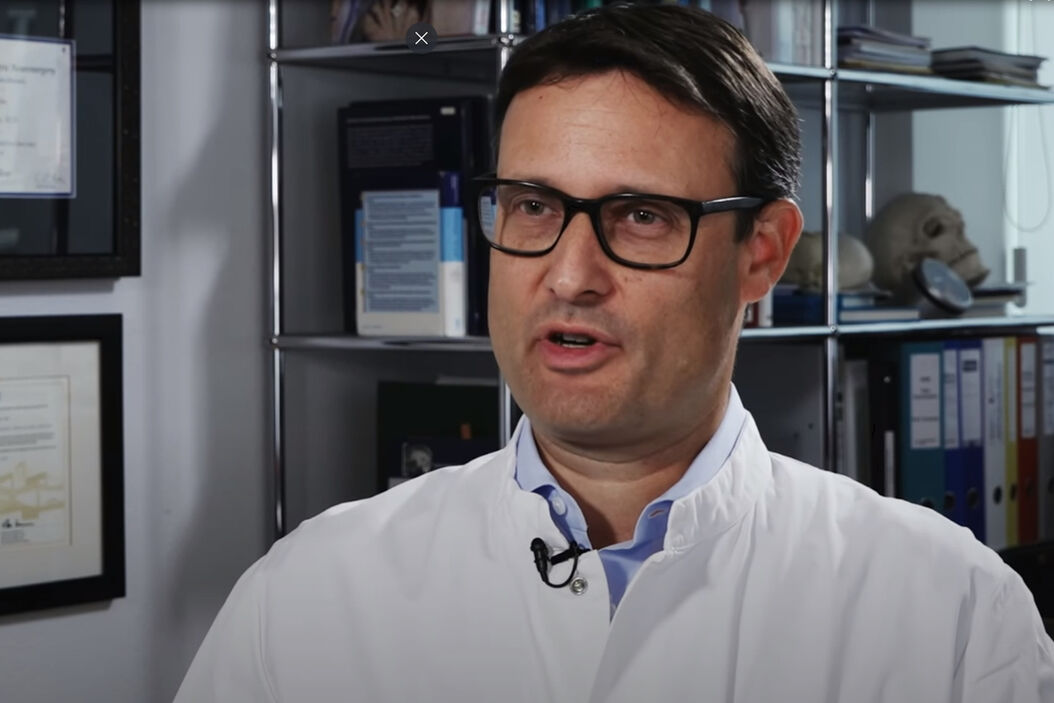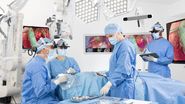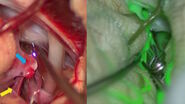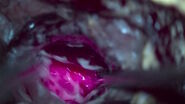Key Learnings
With GLOW800 Augmented Reality fluorescence, the surgeon has a single, augmented view allowing to observe cerebral anatomy and vascular flow. There is no need to step away from the surgical field. Prof. Guzman explains: “I can continue my surgical procedure and wait for the dye to come in, but I keep the full 3D overview of my surgical field.”
At the European Association of Neurosurgical Societies (EANS) 2018 Congress, Prof. Guzman shared two cases of aneurysm surgery demonstrating the benefits of GLOW800. Discover the video below, as well as a full transcript. In another video, he shared his first impressions of GLOW800.
For more information about GLOW800 Augmented Reality fluorescence or the choice of a neurosurgery microscope, contact a Leica representative. Our team will be happy to answer your questions and organize a personalized product demonstration.
About GLOW800 Augmented Reality Fluorescence
GLOW800 Augmented Reality fluorescence and ICG allow to observe cerebral anatomy in natural color, augmented by real-time vascular flow, with full depth perception.
It provides one augmented view during neurovascular surgery for enhanced confidence during aneurysm clipping, AVM removal, microvascular decompression or bypass surgery for example.
GLOW800 Augmented Reality fluorescence can be viewed directly in the eyepieces of the Leica Microsystems M530 OHX neurosurgery microscope. It is also available on the Leica ARveo digital Augmented Reality microscope.
For more information about GLOW800 Augmented Reality fluorescence or Leica neurosurgery surgical microscopes, contact a Leica representative.
The statements of the healthcare professional included in this article reflect only his opinion and personal experience. They do not necessarily reflect the opinion of any institution with whom he is affiliated.
Transcription of Video 1
Clinical experience using ICG with GLOW800 augmented reality fluorescence
“Good morning everybody, it’s a pleasure to be here. My name is Raphael Guzman. I’m a Professor of Neurosurgery at the University of Basel and Vice-chair of the Department of Neurosurgery.
Today I will talk about neurovascular surgery, mainly about aneurysm clipping and the application of GLOW800 as a new modality of Augmented Reality in our neurosurgical practice.
It’s a pleasure to be here at the Leica booth. Today I want to talk about the experience we have had using GLOW800, which is the further development of the ICG, the indocyanine green intraoperative imaging that is mainly used for vascular neurosurgery. I’m sure many of you know ICG and I will talk about this next development.
So, this is an initial experience. We have been using GLOW800 for several months now. I will mainly talk to you about aneurysm surgery and demonstrate, and hopefully convince you, that GLOW800 could be an advantage for your practice in several neurovascular surgeries.
I have just a few disclosures.
[01:49]
What is Augmented Reality? We all hear these words: Augmented Reality, Virtual Reality. So, the difference really is that in Augmented Reality, you have an interactive experience between real-world images – so the images that you are used to seeing on the microscope – and an overlay of an augmented image or of a virtual image that represents an augmentation of normal anatomical structure, and in this sense here, it will be blood vessels.
This Augmented Reality actually helps you to see beyond, things that you haven’t seen just on your white light microscope. You actually can see additional information at the same time as you’re working on your microscope. Now Augmented Reality as I write here can be visual, can be auditory, with different sensory inputs. Here obviously we’re talking about visual inputs.
[02:41]
This is a very simple example – that’s not Leica – of Augmented Reality: a vein finder, something that the anesthesiologist is using. If you don’t see the veins on the surface, you have this little device that can actually augment what you see below the surface, a very useful small tool. But it’s the same idea: we want to see beyond.
What I will do over the next several slides, I will show you some surgical videos of aneurysm cases that were done in the last couple of months.
Case 1
[03:16 – 09:11]
This is a typical MCA aneurysm, a 54-year old male patient, incidental MCA aneurysm, minor trauma imaging like we all see it very often. That shows this fusiform, it was somewhat a bi-lobulated aneurysm. Here on the ICA, it’s kind of a special configuration of the MCA. So, you have the M1 branch and you have a very small temporal branch, but a critical branch as we show in the further imaging on angiogram. And then the major bifurcation here with the sylvian vessels.
You see that the aneurysm is irregularly shaped, with this little nose here that was considered to be at risk for future hemorrhage, therefore indication for surgical clipping was done. All studies are discussed in an interdisciplinary board like all of you know. And here’s the approach, we do a standard mini-pterional craniotomy, exposing the pterional region and then preparing for the surgery.
Here we go directly into the surgery. Here on the right side you have the temporal lobe, frontal lobe. Sometimes I use retractors but with very light pressure, no need to tell you too much about this. You see the MCA that comes around here, we expose the neck of the aneurysm, it’s not a big aneurysm, so we can almost fully expose it.
What you see here, as was shown before, you see this small temporal branch that was adherent to the aneurysm neck and needed to be prepared. So here preparation of this temporal branch, releasing it from the aneurysm so we can actually go beyond the aneurysm for our clipping.
[05:12]
Here you see the final preparation, it’s very important obviously to spare all the vessels, all of you know, no big discussion. We just enjoy some nice images. OK, so here is the clip application, I decided that I could do it with a single clip in the beginning, clip application and complete occlusion of the aneurysm without problem. So standard, after the clipping, is to use the micro-doppler to check for the vessel patency and check therefore for normal flow, that’s what I’m doing here. All these are standard procedures.
Now the next step in aneurysm surgery, usually I do the ICG. So, we are in the dark room and you all know the experience that you are in the dark room and you tell your resident that is next to you: “tell me when the dye is coming into the vessel” because you have a black screen. And that was the problem of ICG. Because the surgeon is actually in the normal field but doesn’t actually realize when the fluorescence contrast comes into the vessel and shows the vessel.
So, what you do, that’s the black screen and it’s always a long time to wait. But this is on purpose, it will eventually come. So, now you see the ICG coming in, and you record the ICG and after ICG is through and I have confirmed that the blood vessels are open, a little dim here, I stop my surgery, I go to the screen, I remember the anatomy and I check if I see all the blood vessels.
But the problem is really, it’s not Augmented Reality because I lost my surgical field. And I also lose the orientation in my 3D environment. So, I have to step away from surgery and that’s something that needs to be improved and I think has been improved now with the implementation of GLOW800.
[07:13]
So now I go to the next generation. Here we see GLOW800. We have the same surgical field, so you imagine I’m still doing my procedure. I’m looking at the blood vessels and through my CaptiView, through the ocular that has an image injection, I will actually see the fluorescence of the blood vessels. With some patients, you will observe how the green contrast will arrive in the blood vessels. And now this is really the Augmented Reality because I can continue my surgical procedure and wait for the dye to come in, but I keep the full 3D overview of my surgical field.
I have the normal depth perception, the depth perception that I have normally with my microscope. I can zoom in and investigate if all the blood vessels are patent. And you see also the cortical surface with the green vessels and you see the aneurysm that has no more flow.
I think this is a true advantage and a true next step for me is to augment what we had before with the black screen, this is GLOW800. Just, not to talk too much about technicalities, but it’s a very simple injection. It’s an IV injection of the dye just like it was with ICG, so I tell my anesthesiologist “I’m ready to do the in-vivo microscopy of the blood vessels”. He injects the dye and a few seconds later it will arrive and I can do my augmented image.
This is just my OR set-up to illustrate a little bit. As always, crowded! We use the Siemens Pheno, that’s the new version of Siemens Zeego to do intraoperative imaging. We do a rotational angiogram; you see the image and I can control my clip placement. I had to leave a little neck so the temporal branch is not obstructed. But this is the usual set-up.
Case 2
[09:12 – 13:38]
Here we have another case, this was a 58-year old female that also had minor traumatic brain injury. And what’s interesting in this case is you will note that the patient had an external or superficial temporal artery aneurysm in addition to this poly-lobulated MCA aneurysm. I let the residents clip the STA aneurysm before I clipped the MCA aneurysm. So, this was a good case, everyone was benefiting from it.
Here you see the 3D pre-op angiogram again, an irregularly shaped, broad-based aneurysm. Nowadays I also use Virtual Reality. It’s a software that was developed in our Bioengineering Department at the University of Basel. So Virtual Reality as a preparation of surgery. I thought I would show this because I think it adds actually in the preparation of surgery. Since I’m free to speak about what I like here, I’ll just show you this.
[10:16]
So, with the residents, I actually go through the cases before we go to the OR. We have a virtual OR light and we can illuminate and actually now study the vascular anatomy of the aneurysm going from all sides. I can really transpose the ideas that we can generate sitting in the library then to the OR. I think this is an added facet of preparing for vascular surgery and we integrate this in the whole process of clipping aneurysms. Again, you see the back wall of the aneurysm that is somewhat again broad-based and poly-lobulated, an important consideration for surgery.
Now you can virtually imagine the aneurysm anatomy and here the actual aneurysm, so this is after the fact. And we see one branch here, and the M2 branch at the bifurcation. We see one branch, it’s a little bit fuzzy, one branch in the back that is this one. So not to be confounded with this early temporal branch that goes away prior to the MCA bifurcation which is this blood vessel here.
[11:21]
Again, I’ll show you a little bit of the case and I’m sorry it looks a little bit blurry. But again, this M2 branch was adherent to the aneurysm neck and after preparation you see the belly here, the ventral belly of the aneurysm that needs to be clipped and you see the other M2 branch in the depths here of the temporal lobe.
And, during the surgery, I sized a few aneurysm clips. First, I thought I might be able to clip it with a curved aneurysm clip, I positioned the clip but I was not satisfied so, in the end, I decided to do a clip reconstruction of the bifurcation, so applying multiple clips and leaving this broad base patent for the emanating M2 blood vessels.
Here is the application of the first clip and again, if you have the virtual image in your mind, it was important to actually get the ventral part of this aneurysm, the ventral of the bifurcation and then a second clip to reconstruct here and a third mini-clip. And here you have this ventral base that was captured by the first clip.
[12:27]
Now, again, we have these two modalities. ICG, that you actually will still have, so the black and white image, ICG, will still be recorded. You still have both but here we see very nicely again this Augmented Reality so I can continue work, I can explore all the blood vessels which before, in the dark image, was complicated.
On this side, you should have, it’s coming, here. We have the NIR, the near infrared image, the classical ICG. And you see my instruments are black, to fill this black, so I don’t really know where I am unless I have this superimposed Augmented Reality of the blood vessel. So, again, I think this is a true advantage of the technology, to make sure that you have all your blood vessels open. Post-surgical result.
So, CaptiView allows you to watch your fluorescence during surgery and you can switch it on and off if you like. And here the example of another blood vessel as seen in CaptiView.
[13’39]
In conclusion, I think we have a very interesting new technology that now separates the black and white image from the augmented GLOW800 image, and this can reconcile both modalities now in one picture, whereas before you had to step away as I mentioned. It’s a real-time image, you have the white light and the fluorescence at the same time.
So, it’s Augmented Reality, it’s real-time, with the full depth perception that you appreciate from your surgical microscope. It keeps you oriented in the field, I think this is critical and I have used it now in several aneurysm cases. I think it will be an important added tool for other pathologies such as AVM. I think especially in AVM you can actually inject and work at the same time, and you see where you have your artery coming in, where your veins are going out like in DAVF fistulas, in bypass surgery.
I think an interesting aspect is tumor surgery, I have applied the technology now is some meningioma cases where I try to spare en-passant artery or I try to spare an important draining vein. You can actually observe during the surgery if you leave all these vessels intact and you can observe if they are en-passant or if they are tumor vessels. I think this is an added indication for this technology. And with this, I will end my presentation. Thank you very much.”
Transcription of Video 2
First impressions of GLOW800 during vascular neurosurgery
“Now we’re talking Augmented Reality. We were looking at FL800, which was the first version, where the background was black and the blood vessels would light up. But now, suddenly, we have the blood vessels lighting up, but we would still see the brain structures around it and that was kind of an “aha” effect. It was an emotional effect because we suddenly could see more, we really got closer to what we think is Augmented Reality.
It is extremely important because in order to keep the anatomy and your 3D structure in sight, you have to see it. Even though we can imagine it, but once you were turning on the FL800, in the first version, the rest of the anatomy disappeared and we would only see the blood vessels.
But now we actually can stay oriented in our 3D environment, while seeing the blood vessels glow up, so this was, to me at least as a neurovascular surgeon, a big advantage and a big achievement.
The first time we used it, it worked. So, it was not like exploring a new technology that might not work, it worked right away and I think that was one critical point because as a surgeon, you want some things to work right away in surgery. You don’t want to try and especially you don’t want to try on patients. And this was working from the first moment on.
I’m quite convinced that this is a very important addition to the armamentarium that we have now and I believe that, in the future, doing appropriate studies, we can also demonstrate the superiority of using a technology like GLOW800.”




